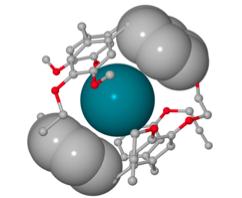
|
A rendering of a water-soluable cryptophane molecule binding a xenon atom.
[Credit: Penn University] |
"We predicted that radon would bind slightly better than xenon, as xenon under-fills the cavity in the cryptophane, and radon is a little bit larger," Dmochowski said. "There is an attractive force between the noble gas atom and the cage, and, if you optimize that interaction by matching the size of the atom and the cage's volume, you can increase the affinity."
"Other researchers made previous measurements of radon's interaction with bulk materials, like charcoal or ice," Jacobson said. "But this is the first measurement of radon binding to a discrete molecule."
The team didn't measure individual radon atoms but rather a solution of radon and a new water-soluble cryptophane. The cryptophane was synthesized for the first time in their lab, but acquiring an appreciable amount of radon was a bigger challenge. Jacobson made several trips to the NIST facility in Maryland, where the experiment was conducted using NIST's standard method for safely generating and working with the element.
At the core of the method are capsules of another radioactive element, radium, which were developed by NIST researcher and co-author Ronald Collé. The team placed the capsules into sealed vials of water. As the radium decayed, the gaseous radon leached out. After a period of a few days, the researchers were left with a precise amount of radon dissolved in the water that was then carefully transferred into a series of sealed vials containing different amounts of cryptophane.
"Some of the radon eventually evaporates out of the liquid phase inside the sealed vessels," Jacobson said. "We showed that the amount that's left behind in the liquid phase is more when there's more cryptophane to hold it within the liquid."
Less free radon gas indicates that the element was binding to the cryptophane. To measure exactly how much radon was bound, the team used a process known as liquid scintillation.
"Because radon is radioactive, we can take the liquid and inject it into a cocktail that fluoresces when something undergoes radioactive decay," Jacobson said. "We then put that into a machine that counts the number of fluorescence incidents."
From that measurement, the team was able to determine radon's "affinity constant," a measure of how much radon was bound to cryptophane at a given temperature.
The principles behind making this determination could be used on different binding targets.
"Now that we have a robust method for measuring radon binding to discrete entities, we could apply it to things like proteins found in the lungs," Dmochowski said. "If you know radon's affinity for those proteins, you have a better idea of the concentration and timescale over which it will be dangerous."
Better radon-binders could be also used to extract the dangerous element from groundwater, for example, and the same principle could be used to harvest xenon from the atmosphere. Xenon is relatively safe and has a wide range of medical and industrial uses.
Dmochowski's group is interested in using xenon for making better MRI contrast agents, but the gas is also used in plasma televisions, lasers and ion propulsion systems for deep space satellites.



